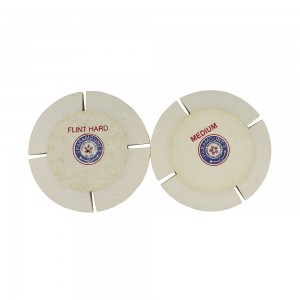In the highly competitive market of polishing and buffing wheels, wool felt wheels are locked in a fierce battle with synthetic alternatives for market dominance. Both types of wheels have their own strengths and weaknesses, and as industries and consumers become more discerning, understanding the differences between them is crucial for making the right choice.
Wool felt wheels, crafted from natural wool fibers, offer several distinct advantages. Their softness is unparalleled, making them ideal for polishing delicate surfaces without causing damage. For example, when working with precious metals like gold and silver, wool felt wheels can achieve a high – gloss finish while preserving the integrity of the metal. The natural fibers also have excellent heat – dissipation properties, which is essential in applications where friction generates a significant amount of heat, such as in automotive paint correction. Additionally, wool felt wheels are often more environmentally friendly, especially when sourced from sustainable wool producers, which appeals to the growing number of eco – conscious consumers.
On the other hand, synthetic polishing wheels, made from materials such as nylon, polyester, or foam, have their own set of benefits. They are generally more affordable than wool felt wheels, making them a popular choice for budget – conscious users. Synthetic wheels can also be designed with specific abrasive properties, allowing for faster material removal in some cases. For heavy – duty industrial applications where rough surfaces need to be quickly smoothed out, synthetic wheels may be more suitable. They are also often more resistant to chemicals and moisture, which can be an advantage in certain working environments.
The competition between wool felt wheels and synthetic alternatives is most evident in the automotive and metalworking industries. In automotive detailing, some professionals prefer wool felt wheels for their ability to provide a swirl – free finish on painted surfaces. However, synthetic microfiber pads are also gaining popularity due to their ease of use and lower cost. In metalworking, while wool felt wheels are favored for fine polishing and buffing of high – value metal components, synthetic abrasive wheels are commonly used for initial surface preparation and heavy – duty grinding tasks.
Consumer perception also plays a significant role in this market battle. Many DIY enthusiasts and hobbyists are attracted to the affordability and wide availability of synthetic wheels. However, as awareness of the quality and performance benefits of wool felt wheels grows, there is a shift towards more high – end, professional – grade users choosing wool felt wheels for their superior results.
To stay competitive, manufacturers of both wool felt wheels and synthetic alternatives are constantly innovating. Wool felt wheel manufacturers are focusing on improving durability, reducing costs, and expanding their range of applications. Synthetic wheel manufacturers, on the other hand, are working on enhancing the softness and precision of their products to compete more effectively in the market segments traditionally dominated by wool felt wheels.
As the market continues to evolve, the outcome of this battle for dominance remains uncertain. It is likely that both wool felt wheels and synthetic alternatives will coexist, each carving out their own niche based on the specific needs and preferences of different industries and consumers.

Post time: Jun-05-2025
